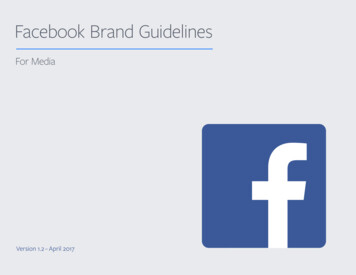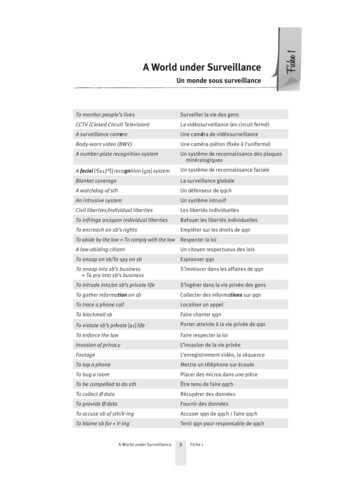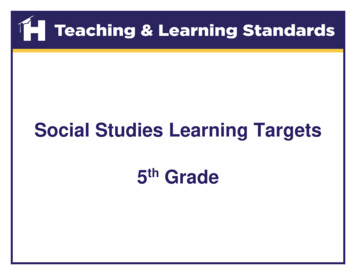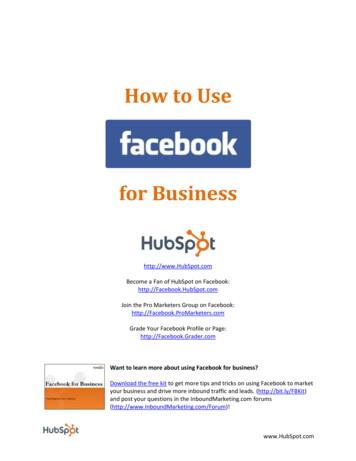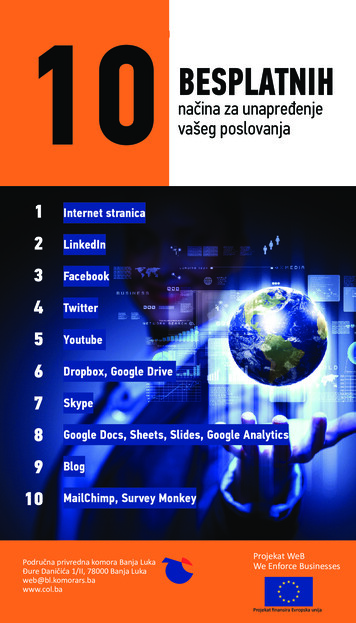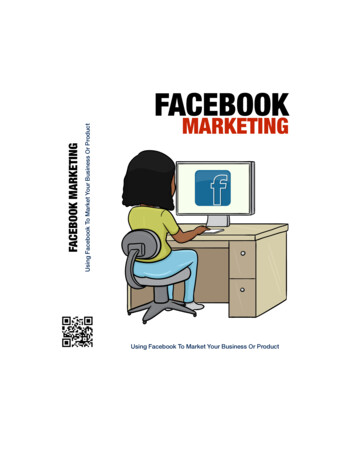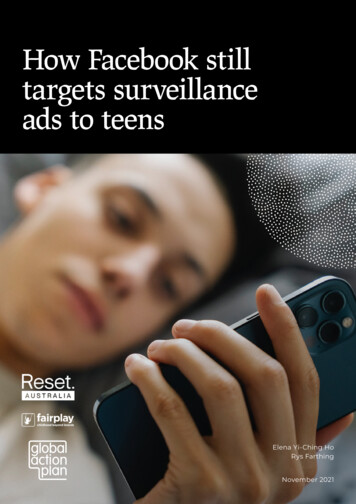
Transcription
How Facebook stilltargets surveillanceads to teensElena Yi-Ching HoRys FarthingNovember 2021
Executive Summary There are many concerns around the impacts of surveillance advertising on children.Data-driven advertising can be more misleading for children than traditional advertisingand can increase commercial pressures leading to consumerism, disappointment andparent-child conflict, all with associated consequences for mental health and wellbeing.Multiple jurisdictions around the world have passed regulations, or are in the process ofenacting them, to address this. On July 27th of this year, Facebook (now Meta) announced changes to its advertisingrules for children, claiming to have ‘heard from youth advocates’ about these concerns.Facebook stated that ‘we agree with them, which is why we’re taking a moreprecautionary approach in how advertisers can reach young people’. This precautionaryapproach meant “that previously available targeting options, like those based oninterests or on their activity on other apps and websites, will no longer be available toadvertisers’. However, this research demonstrates that Facebook has not limited the use ofsurveillance advertising. Facebook is still harvesting children’s personal data to fuel theiradvertising delivery system. The only difference is that the targeting is ‘optimised’ by ahighly trained AI ‘Delivery System’. The replacement of targeting ‘selected by advertisers’ with targeting ‘selected by an AIdelivery system’ does not represent a demonstrable improvement for children in the waythat Facebook characterised in their announcement and reiterated at a US Senatecommittee hearing. This is not a precautionary approach. Given the predictive power ofAI, this system may in fact be worse for children. We are calling on Facebook to go on record to correct their claims, and end surveillanceadvertising for children and teens across all their platforms.Note: Facebook recently renamed their parent company Meta. This report refers to Facebook asboth the platform and the parent company, for consistency across the timeline.
ContentsSurveillance advertising and childrenFacebook’s response to concerns about surveillance advertisingChildren and teen’s data is still being harvestedConclusion and recommendationsAppendix: Relevant legislation and regulationReferences124678
Surveillance advertising and childrenMarketing to children is, by intent and design, manipulative. But with surveillance advertising —targeted advertising using personal data provided by websites and platforms,1 and thecornerstone of Facebook’s business model — this manipulation is intensified by a hugeasymmetry of ability and information.On the one side is a child, poorly equipped to distinguish between advertising and information,especially within digital contexts.2 On the other, Facebook with its vast troves of data about thechild, including but not limited to their browsing history, mood3, insecurities, their peers’interests, and more. This power imbalance makes surveillance advertising inherently moremanipulative than contextual digital advertising, let alone traditional analogue advertising. Forexample, ads for risky "Flat Tummy Teas" or dangerous exercise routines reach young women onInstagram known to be vulnerable to these harms.The personalised nature of surveillance advertising, where children are specifically ‘targeted’ fortheir perceived commercial vulnerabilities, exacerbates many of the known impacts marketingto children: Advertising and increased commercial pressures on children can lead to consumerism4,disappointment and frustration and parent-child conflict,5678 all of which have associatedconsequences for children’s wellbeing and mental health. Advertising contributes to a culture of unsustainable and often unhealthy consumerism.9 10There is also emerging evidence that children and young people themselves resent beingtargeted by surveillance advertising, with a recent Australian poll finding that 82% of 16 & 17 yearolds have come across ads that are so targeted they felt uncomfortable.11 Likewise, 65% ofAustralian parents were uncomfortable with businesses targeting ads to children based oninformation they have obtained by tracking a child online.12 Similarly, 88% of US parents believe“the practice of tracking and targeting kids and teens with ads based on their behavioralprofiles” should be prohibited.13‘It concerns me how accurately advertisers can target me from things I was unaware they could collectdata from’ - Young man 17, AustraliaDespite these concerns, the practice is ubiquitous. One estimate suggests that by the time achild turns 13, advertisers already hold over 72 million data points about them,14 and thesurveillance advertising industry for children is worth in excess of 1bn US.15Facebook has faced strong international criticism for their surveillance advertising practices tochildren. Earlier this year, youth advocates in Australia and the US outlined that Facebook’stargeting processes allowed advertisers to target children interested in alcohol, gambling andweight loss.16 171
Facebook’s response to concerns about surveillance advertisingFacebook appeared to have responded to these concerns. On July 27th, potentially inanticipation of the UK’s Age Appropriate Design Code coming into force, Facebook announcedthat:“Starting in a few weeks, we’ll only allow advertisers to target ads to people under 18 (orolder in certain countries) based on their age, gender and location. This means thatpreviously available targeting options, like those based on interests or on their activityon other apps and websites, will no longer be available to advertisers. These changeswill be global and apply to Instagram, Facebook and Messenger. .We already give people ways to tell us that they would rather not see ads based on theirinterests or on their activities on other websites and apps, such as through controlswithin our ad settings. But we've heard from youth advocates that young people maynot be well equipped to make these decisions. We agree with them, which is why we’retaking a more precautionary approach in how advertisers can reach young people withads.” 18Indeed at a US Senate Committee on Commerce, Science and Technology hearing onSeptember 30th, Facebook’s Global Head of Safety again implied that Facebook has reined in thepractice. When asked by Senator Cynthia Lummis if Facebook were exploring the manipulativeeffects of “highly personalized advertising” on children, Facebook’s Global head of Safety Ms.Antigone Davis stated:“We have very limited advertising to young people. You can only actually now target ayoung person based on their gender, age, or location. For Messenger, kids are at orunder 13, we actually don’t allow ads at all. And I think we would want to know how wecan safely provide an experience for young people on our apps in relation to advertising,and that’s why we have our rules in place.” 19The implication of this statement and Facebook’s initial announcement are clear: Facebook weretaking a new precautionary approach to mitigate the effects of “highly personalised advertising”,by only allowing targeting to young people based on gender, age and location.Suspicions were immediately raised. The move was described as an ongoing continuation ofFacebook’s algorithmic ad playbook that would have no impact on how advertisers reachedunder 18s on Facebook, Instagram or Messenger. “Advertisers can probably still be profitable inreaching people under 18 simply by setting a broad age and gender audience target and feedingFacebook the conversion data that enables its algorithm to decide who to reach with ads”20, saidthe founder of a Facebook Audience Targeting Tool.2
On October 5th 2021, in her testimony to the same US Senate Committee, whistleblower Ms.Frances Haugen repeated this concern:“I’m very suspicious that personalised ads are still not being delivered to teenagers onInstagram, because the algorithms learn correlations. They learn interactions whereyour party ad may still go to kids interested in partying, because Facebook almostcertainly has a ranking model in the background that says this person wants moreparty-related content.” 21The sort of personalisation by algorithm can be extremely potent. As Facebook themselvesoutline:“the delivery system uses machine learning to improve each ad's performance. Eachtime an ad is shown, the delivery system's predictions of relevance become moreaccurate. As a result, the more an ad is shown, the better the delivery systembecomes.” 22Following Ms Haugen’s suspicions, we wanted to investigate and see if Facebook was still servingup surveillance advertising to children’s accounts.3
Children and teen’s data is still being harvested as part of Facebook’s surveillanceadvertising systemTo understand this, we wanted to see if data about children’s browsing history, online activitiesetc, is still being harvested by Facebook to enable targeted advertising. This involves looking atConversion APIs, such as Facebook Pixel and app SPK, which are used exclusively to gatherinformation for advertising purposes.23Facebook’s promotional material outlines that this data is used to deliver targeted advertising.Data from conversion APIs is fed into Facebook’s machine learning enabled advertising ‘DeliverySystem’.24 This ‘Delivery System’ is an extremely powerful algorithm that is able to predictadvertising that each user may interact with. This is the system that delivers all of us the eerilyaccurate ads into our feeds; it is so accurate that there is a widespread fear that Facebook mustbe ‘listening’ to our conversations to feed us advertising that is so accurate.25We then wanted to see if this data from conversion APIs triggered a change in advertising inyoung people’s feeds.MethodWorking with journalist Matthias Eberl we wanted to see if Facebook is still harvesting data usingConversion APIs from the accounts of under 18 year olds. We established three experimentalFacebook accounts on clean browsers. One account was registered by the age of a 13 year oldand the other two for 16 year olds. To ensure safeguarding, these accounts were deleted after thisexperiment, and no contact was made with other children from these accounts.FindingsWe were able to capture evidence of Facebook collecting Facebook Pixel26 data from all threeaccounts. Our test account browsed a number of webpages containing an embedded FacebookPixel. As the test account was logged in to Facebook, data about these visits could be identifiedby Facebook Pixel because of the login Cookie ‘c user’.Using this Facebook Pixel data, Facebook can collect data from other browser tabs and pagesthat children open, and harvest information like which buttons they click on, which terms theysearch or products they purchase or put in their basket (‘conversions’) (see figure 1). There is noreason to store this sort of conversion data, except to fuel the ad delivery system.4
Figure 1: A screenshot from Facebook’s system, showing the off-Facebook activity captured bythe platform (cropped to show the first 5 of 25 links we clicked on). We browsed those pagescontaining Facebook Pixel in the same browser where we logged in to our test account. Thisscreenshot is from Facebook’s own system, showing the number of activities collected. This isthe ‘event data’ from Facebook pixel.This demonstrates that Facebook’s ad Delivery system is still harvesting children and teenagersdata.5
Conclusion and recommendationsFacebook’s ad delivery system continues to harvest teens’ data, for the sole purpose of servingthem surveillance advertising, with all the associated concerns. Replacing ‘targeting selected byadvertisers’ with ‘targeting optimised by AI’ does not represent a demonstrable improvement forchildren in the way that Facebook characterised this in both their initial announcement and MsDavis’ Senate testimony. It is, in all likelihood, worse.Facebook must:1.Provide more transparency about the impacts of its recent rule changes inadvertising to teens, and clarify if this is an improvement for children. It appears thatyoung people’s personal data is still being harvested to deliver them a stream ofeven more personalised advertising with all of the associated risks. If this is correct,Facebook must go on record and correct any confusion Ms Davis’ statements onSeptember 30th 2021 may have created.2.Commit to ending surveillance marketing to children, in all its forms.6
Appendix: Relevant legislation and regulationA number of countries have recently implemented laws and regulations that may curb thesurveillance advertising, including: The UK. Principle 5 of the Age Appropriate Design Code27 stipulates that data processorsmust not ‘use children’s personal data in ways that have been shown to be detrimentalto their wellbeing, or that go against industry codes of practice, other regulatoryprovisions, or Government advice. This statutory Code has only been enforced since Sept2021, and it is unclear if regulators will interpret the Code as requiring curbs onsurveillance advertising given the risks of this advertisingFrance. Principle 8 of Les Droits Numériques des Mineurs28 stipulates that platformsmust ‘provide for deactivation by default of profiling devices for minors, in particular foradvertising targeting purposes’ andSweden: Principle 9 of the Barns och Ungas Rättigheter på Digitala Plattformar29 whichstipulates that processors who use children’s data for marketing purposes ‘must alwaysstart from what is judged to be in the best interests of the child’Speaking to the urgency of the issue, a number of jurisdictions are also looking at implementingregulations that may call to curtail this practice: In the US, two bills are currently in front of Congress that would ban surveillanceadvertising for children. In the House of Representatives, Representative Castor hasintroduced the Protecting the Information of our Vulnerable Children and Youth Act(Kids PRIVCY Act), which would prohibit companies from targeting children based ontheir personal information and behaviour.30 In the Senate too, Senators Markey andCassidy have reintroduced the Children and Teen Online Privacy Protection Act31In Australia, the proposed Online Privacy Bill32 stipulates that data can only be collectedand used in the best interests of children. While the Bill and the Code it leads to is yet tobe developed, given the evidence against surveillance advertising, it is difficult to seehow surveillance advertising would be in children’s best interestsIn Ireland, the draft Fundamentals for a Child Oriented Approach to Data Processingstipulates that platforms ‘should not profile children and/ or carry out automateddecision making in relation to children, or otherwise use their personal data, formarketing/advertising purposes due to their particular vulnerability and susceptibility tobehavioural advertising, unless they can clearly demonstrate how and why it is in thebest interests of the child to do so.’33 The Irish code is very clear about its intent to curtailsurveillance advertising, but is currently in draft form. It is expected to be updatedshortly.7
an McCann 2021 iSpy: The Billion Dollar Business of Surveillance Advertising to KidsNew Economics Foundation / Global Action Planhttps://neweconomics.org/uploads/files/i-Spy NEF.pdfLaura Owen, Charlie Lewis, Susan Auty, Moniek Buijzen 2012 ‘Is children’s understandingof non–traditional advertising comparable to their understanding of televisionadvertising? Journal Public Policy Mark. 2012;32(2):195–206 doi.org/10.1509/jppm.09.003Sam Levin 2017 ‘Facebook told advertisers it can identify teens feeling 'insecure' and'worthless’’ The he more we aspire towards materialistic goals, the more likely we are to have lowerwellbeing, including higher rates of anxiety, depression, loneliness, lower self-esteem andhigher levels of debt. Dittmar, H., Bond, R., Hurst, M., & Kasser, T. (2014). The relationshipbetween materialism and personal well-being: A meta-analysis. Journal of Personality &Social Psychology, 107, 879 924 doi.org/10.1037/a0037409Matthew Lapierre, Frances Fleming-Milici, Esther Rozendaal, Anna R McAlister, JessicaCastonguay 2017 ‘The Effect of Advertising on Children and Adolescents’ PediatricsNov;140(Suppl 2):S152-S156.doi: 10.1542/peds.2016-1758VSandra Calvert 2008 ‘Children as Consumers: Advertising and Marketing’ Future ChildSpring 18(1):205-34. doi: 10.1353/foc.0.0001Amani Al Abbas, Weifeng Chen & Maria Saberi 2019 ‘The Impact of NeuromarketingAdvertising on Children: Intended and Unintended Effects’ Annual PwR DoctoralSymposium 2018–2019 icle/view/5187Moniek Buijzen, Patti Valkenburg 2003 ‘The effects of television advertising onmaterialism, parent–child conflict, and unhappiness: a review of research’. JournalApplied Developmental Psychology 24(4):437–456 doi.org/10.1016/S0193-3973(03)00072-8Duncan McCann 2021 iSpy: The Billion Dollar Business of Surveillance Advertising to KidsNew Economics Foundation / Global Action Planhttps://neweconomics.org/uploads/files/i-Spy NEF.pdfOliver Hayes & Natasha Parker (n.d.). Kids for sale Global Action Plan.https://www.globalactionplan.org.uk/ files/kids for sale.pdfDylan Williams, Alex McIntosh & Rys Farthing 2021 Keep it to a Limit Reset stralia policymemo pollingreport final-oct.pdfOffice of the Australian Information Commissioner 2020 Australian CommunityAttitudes to Privacyhttps://www.oaic.gov.au/ data/assets/pdf rivacy-survey-2020.pdfAccountable Tech 2021 Accountable Tech Frequency Questionnaire /Accountable-Tech-Parents-Poll.pdfSuper Awesome 2017’ Safe Filter to Prevent Online Ads from Stealing Children’s -ads-from-stealing-childrens-personal-data/Duncan McCann 2021 iSpy: The Billion Dollar Business of Surveillance Advertising to KidsNew Economics Foundation / Global Action Planhttps://neweconomics.org/uploads/files/i-Spy NEF.pdf8
16. Dylan Williams, Alex McIntosh & Rys Farthing 2021 Profiling Children for AdvertisingReset stralia profiling-children-for-advertising-1.pdf17. Tech Transparency Project 2021 ‘Pills Cocktails and Anorexia’ mful-ads-target-teens18. Instagram 2021 ‘Giving Young People a Safer, More Private -experience19. Rev Transcripts 2021’Facebook Head of Safety Testimony on Mental Health Effects: FullSenate Hearing fects-full-senate-hearing-transcript20. Kate Kaye 2021 ‘Why Facebook’s limits on teen targeting are all part of its algorithmic adplaybook’ Digiday Aug mic-ad-playbook/21. Rev Transcripts 2021 ‘Facebook Whistleblower Frances Haugen Testifies on Children &Social Media Use: Full Senate Hearing anscript22. Facebook nd ‘About Ad 1000688343301256?id 56190637758703023. Facebook nd ‘Retargeting Starts with Finding People who have Engaged with yourBusiness’ g24. Facebook nd ‘About Ad 1000688343301256?id 56190637758703025. Ben Gilbert 2019 ‘There's a wildly popular conspiracy theory that Facebook listens to yourprivate phone calls, and no matter what the tech giant says, people just aren't convincedit's not true’ Business s-listening-to-you-2019-5?r US&IR T26. An advertising specific conversion APIs. See for example, Facebook nd ‘RetargetingStarts with Finding People who have Engaged with your /retargeting27. Information Commissioner’s Officer (UK) 2021 ‘Age Appropriate Design es/28. CNIL(France) 2021 ‘Les droits numériques des ques-des-mineurs29. Barn Ombudmannen (Netherlands) 2020 ‘Barns och Ungas Rättigheter på digitala-plattformar.pdf30. Kathy Castor (US) 2021 ‘Castor Introduces Kids PRIVCY Act to Strengthen le.aspx?DocumentID 40319531. Ed Markey (US) 2021 ‘Senators Markey And Blumenthal, Rep. Castor ReintroduceLegislation To Protect Children And Teens From Online Manipulation And ns-from-online-manipulation-and-harm9
32. Office of the Attorney General (Australia) 2021 ‘Draft Exposure Bill: Enhancing draft/33. Data Protection Commission (Ireland) 2020 ‘Fundamentals for a Child OrientedApproach to Data ssing Draft%20Version%20for%20Consultation EN.pdf10
under 18s on Facebook, Instagram or Messenger."Advertiserscan probably still be profitable in reaching people under 18 simply by setting a broad age and gender audience target and feeding Facebook the conversion data that enables its algorithm to decide who to reach with ads"20, said the founder of a Facebook Audience Targeting Tool. 2



